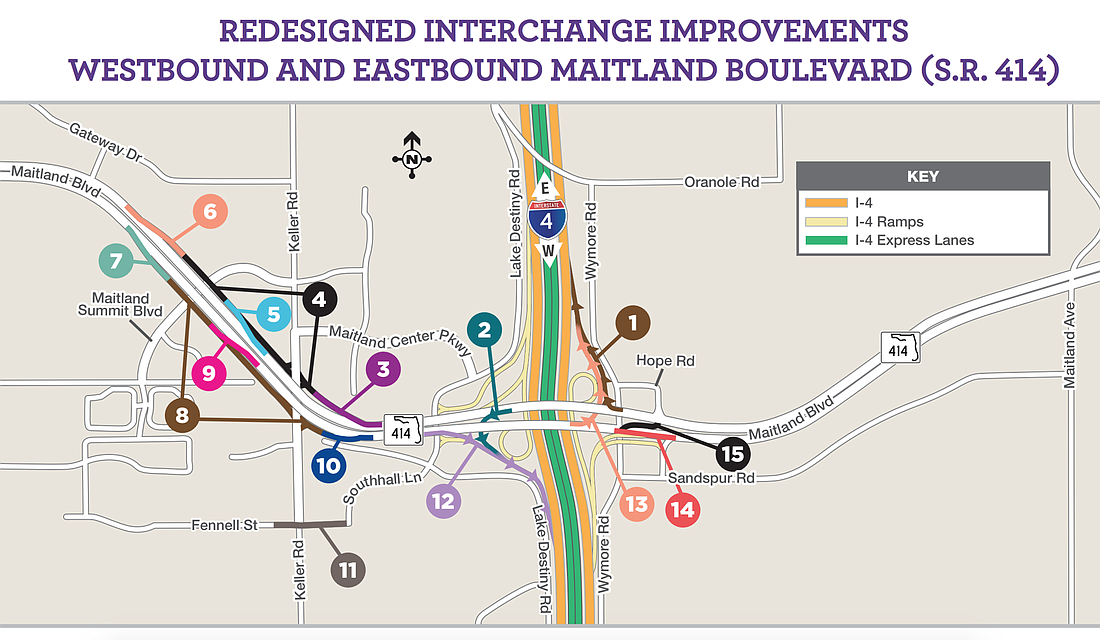- April 18, 2024
-
-
Loading

Loading

The seemingly constant construction being done on Interstate 4, also known as the I-4 Ultimate Improvement Project, has affected quite a few communities — including Maitland.
Although the end goal is, of course, to help make the roads easier to navigate and drive, construction always gives locals headaches.
Howefer, improvements have been made and the situation is getting better, said Maitland City Manager Sharon Anselmo.
“They made changes probably about six months ago — it was quite harrowing — there were daily changes and a lot of construction going on,” Anselmo said. “At this point, I think the westbound direction has improved considerably.
“If you take it from Maitland Boulevard all the way through to Bear Lake and Apopka — you can pretty much go straight all the way through, and maybe stop at the light at Bear Lake,” she said. “It’s a pretty amazing improvement.”
The work on westbound Maitland Boulevard is complete, Anselmo said.
Based on the Florida Department of Transportation’s plans regarding the improvements to Maitland Boulevard, the development on the westbound lanes involved six-different key components: a new eastbound I-4 entrance ramp; a new westbound I-4 entrance ramp on the left side of westbound Maitland Boulevard that crosses underneath eastbound Maitland Boulevard; a new exit ramp to realigned Keller Road; a new ramp from Maitland Boulevard to both Keller Road and Maitland Summit Boulevard; and a new entrance ramp from Maitland Summit Boulevard to Maitland Boulevard.
Anselmo said once all the alignments and the new ramps are set, people will be able to easily cross Maitland Boulevard like never before.
“When they’re done, you’ll be able to pass underneath Maitland Boulevard — say you’re at the RDV, you can get to the Chick-fil-A on the other side,” Anselmo said. “So it definitely opens it up for pedestrians to get from one side of Maitland Boulevard to the other, under Maitland Boulevard.”
Along with the ability to walk underneath Maitland Boulevard, pedestrians also will be able to actually freely walk or bike across I-4 itself with the building of a pedestrian bridge that will be connecting Lake Destiny and Wymore roads.
The bridge, part of the overall $2.3 billion Ultimate project, currently is planned to open in 2019.
“We have received calls from a lot of folks who are really excited about that, because it finally connects the east and west side of Maitland in a pedestrian/bicycle friendly way,” Anselmo said.
Pedestrians won’t be the only ones who will be able to move about the roadways more easily. By raising Maitland Boulevard over Lake Destiny Road, Keller Road, and Maitland Summit Boulevard, the improvements means those driving down the boulevard will face fewer traffic lights.
While things are going much smoother on the westbound side, the eastbound side is a different story.
With at least another year of construction still on the horizon, the eastbound lanes of Maitland Boulevard will include many of the same adjustments that the westbound lanes faced, Anselmo said.
The eastbound lanes, like the westbound, will cross over Maitland Summit Boulevard, Keller Road and Lake Destiny. New entrance ramps on to I-4 eastbound and west bound also will be added.
The only difference between westbound and eastbound construction is that in the eastbound section Southhall Lane will be connected to Keller Road, while the Sandspur Road entrance ramp from eastbound Maitland Boulevard will be removed — new left turn lanes to Hope Road will replace the exit to Sandspur Road.
While the construction is ongoing, Anselmo said city officials keep in contact with the I-4 Ultimate team whenever they need to address anything, including complaints from residents — which generally relate to noise and changes to traffic flow.
“We pass on as much information (as possible), as well as if we get feedback — positive or negative — we will follow up with FDOT,” Anselmo said. “But on 17/92, we work with FDOT and we have had our traffic engineer out there making recommendations.
“At this point synchronizing the lights and having the appropriate signal timing is really what helps traffic move,” she said. “There is no real way to reduce it.”